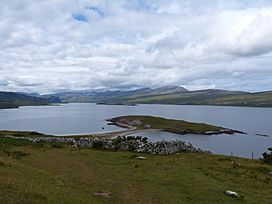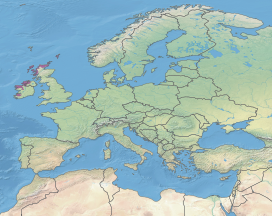North Atlantic moist mixed forests facts for kids
Quick facts for kids North Atlantic moist mixed forests |
|
|---|---|

Loch Eriboll, in Northern Scotland
|
|

Map of North Atlantic moist mixed forests
|
|
| Ecology | |
| Realm | Palearctic |
| Biome | Temperate broadleaf and mixed forests |
| Borders | Celtic broadleaf forests and Caledonian forest |
| Geography | |
| Area | 22,000 km2 (8,500 sq mi) |
| Countries | Republic of Ireland, United Kingdom (Northern Ireland and Scotland) and Denmark (Faroe Islands) |
| Conservation | |
| Conservation status | Critical/endangered |
The North Atlantic moist mixed forests are a special type of ecoregion found in Northwestern Europe. Think of an ecoregion as a large area with similar plants, animals, and climate. This particular ecoregion has forests and open lands called heaths.
You can find these unique forests and heaths along the western and northern coasts of Ireland, Scotland, and on nearby islands. Sadly, this area has lost a lot of its natural homes for plants and animals over time.
Contents
Where Are the North Atlantic Moist Mixed Forests Located?
This ecoregion stretches along the western and northern coasts of Ireland and Scotland. It starts in southwestern Ireland and goes all the way up to the north coast of Scotland. It also includes several islands like the Hebrides, Shetland, Orkney, and Faroe islands.
What Plants Grow in These Forests?
The North Atlantic moist mixed forests are home to several interesting plant communities. These are groups of plants that naturally grow together in certain areas.
Pine Forests and Deciduous Trees
One type of plant community is the Hemiboreal pine forest. These forests are mostly made up of Scots pine trees, which are evergreen. Mixed in with the pines are also deciduous broadleaf trees. Deciduous trees lose their leaves in the fall, unlike evergreens.
Atlantic Dwarf Shrub Heaths
Another important plant community is the Atlantic dwarf shrub heath. These areas are covered with low-growing shrubs, different kinds of grasses, herbs, and mosses.
Dry Heaths
In the drier parts of the heaths, you'll find plants like ling (also called heather), bell heather, cross-leaved heath, and blaeberry. These plants are well-suited to the drier conditions.
Wet Heaths
In the wetter parts of the heaths, you'll see shrubs like Erica tetralix and bog-myrtle. You'll also find a type of grass called purple moor-grass and a plant from the sedge family called Scirpus cespitosus.
Ombrotrophic Mires (Quaking Bogs)
In north-central Scotland, there are special wet areas called ombrotrophic mires, also known as quaking bogs. These bogs get all their water and nutrients from rainfall, not from groundwater.
What Animals Live in These Forests?
The North Atlantic moist mixed forests are home to several animals that have adapted to this unique environment.
What Threats Do These Forests Face?
The forests in western Scotland and Ireland have suffered a lot. They have lost much of their natural habitat due to deforestation, which means cutting down too many trees. Also, hunting used to be a big problem for the animals that lived here.
Many animals that once lived in these forests are now gone. For example, the grey wolf, wild boar, brown bear, European bison, Eurasian lynx, tarpan, and golden eagle used to roam freely. However, because of too much hunting and too many trees being cut down, these animals lost their homes and disappeared from the area.
Because of these serious problems, the World Wildlife Fund has classified the North Atlantic moist mixed forests ecoregion as critical/endangered. This means it's in great danger and needs help to survive.
How Are These Areas Protected?
To help protect these important natural areas, several places within the ecoregion have been made into protected areas. These areas aim to keep the plants and animals safe.
- Caithness and Sutherland Peatlands Special Protection Area (1453.13 km²), Scotland
- Glenveagh National Park (334.46 km²), Republic of Ireland
- Lewis Peatlands (589.84 km²), Scotland
- Stack’s to Mullaghareirk Mountains, West Limerick Hills and Mount Eagle Special Protection Area (556 km²), Republic of Ireland
A Look Back in Time: Prehistory of the Ecoregion
This ecoregion is quite young when it comes to human settlement. That's because a huge ice age covered the area less than 10,000 years ago. After the ice melted, people started to move in.
The first people, called Mesolithic peoples, were definitely living in the Irish part of this ecoregion about 9,000 to 8,000 years ago. Later, they also settled in the western Scotland areas of these forests.
Then came the Neolithic period, when farming began. People learned how to grow grains and take care of livestock. This time also saw the creation of early monumental sites, like standing stones and stone circles, which you can still see in the region today.

